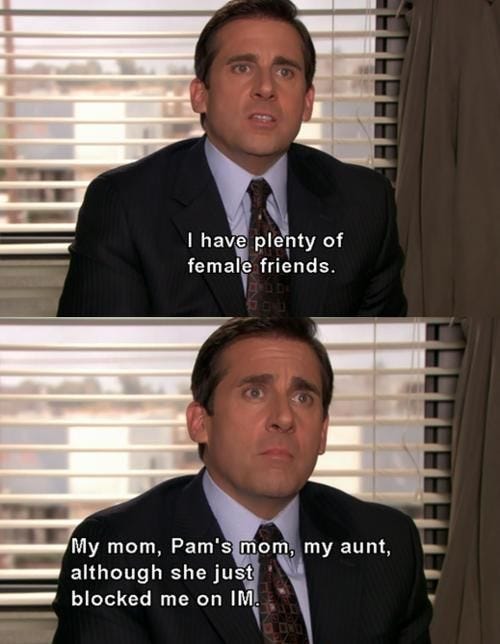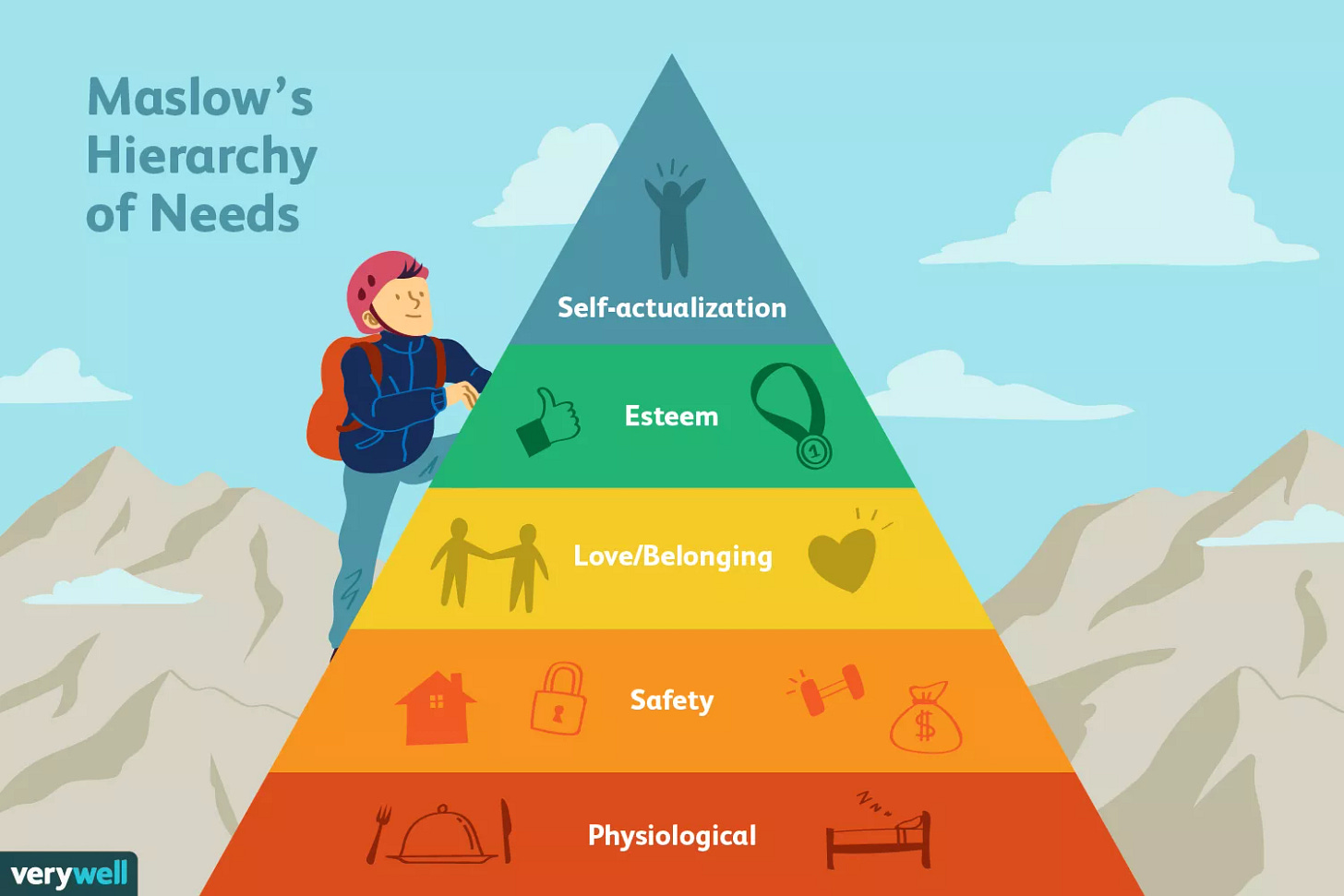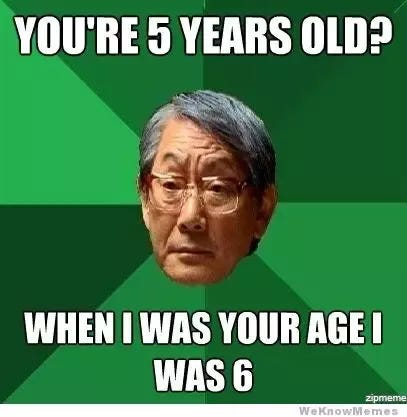#6 - Maslow's hierarchy of life-crisis - part 1
Why was Michael Scott desperate for love & friendships?
Have you ever wondered why Michael Scott was so fixated on finding love and friendships? To the point where he would put everything else on the line for one shot at getting those. Let’s warm up by evaluating Michael’s close circle of female friends.
Yup, short but not very sweet.
You must be aware of the terms quarter-life crisis or if you are old enough, even mid-life crisis. If not, here is quick primer. If you ever felt that you had no idea on what you were doing with your life. Everything felt meaningless and absurd so much that you made some radical changes to get back to feeling like yourself. Then, yes, you might have had one of these "life crisis" situations. Remember your friend, who gave up a cushy, high-paying job to travel for 3 months and then, ended up starting a bakery?
or perhaps, they started a startup that helps bakeries gets customers but you get the idea.
So, depending on the age of the subject, the crisis is then called as a quarter-life crisis or a mid-life crisis and so on. For example, let's say Dana feels at 25 that her Digital Marketer job is shallow and lacks higher purpose. She feels unfulfilled and doesn't feel connected with her work. So, she starts thinking about changing things up and goes through a period of emotional volatility. This period entails therapy, broken friendships, new friendships, break-ups, a change in personality, shaved heads, etc. . The end result of this period is different for everyone.
Many people come out of it with only minor changes to their lives like adding community service 2 nights a week to their life. For others, this period brings deep and long lasting changes like new relationships, changed careers, changed mental-models about life. Since the average life expectancy (in the US) is 80+, Dana's crisis is a quarter-life crisis. Mid-life crisis is when people go through these periods in their 40s and 50s.
Ok, so now everyone is on the same page hopefully. Do some of your own research if you are still not.
For the past two months, I have been working on a question.
What is the impetus of the human quarter-life and mid-life crises?
What causes Bill to reevaluate his whole life and change things up at 50 years of age?
What causes 30 year olds to give up their nice jobs to travel the world while making significantly less money?
Why do people to abandon long relationships to start a rock band?
A lot of introspection, reflection, and discussion with close friends brought me to this conclusion.
People go through quarter/mid-life crisis when their focus shifts from one level to the other in Maslow's hierarchy of needs.
The mental models used to achieve the "success state" in one level of the hierarchy of needs, differ from the mental models needed to excel in the other level.
This shift is accompanied by great emotional upheaval as it challenges the very "truths" with which one leads their life.
Simply put: You always thought that when you get that nice tech-job and move to California, you will be happy but that didn’t do it. The reason is that as soon as you achieve the “Esteem” needs, your focus shifts to the next set of needs. It could be “Love/Belonging” needs if those are unmet or maybe “Self-Actualization” needs. Since the tactics you need for the new set of needs is different, it causes discomfort, as you have to shift and realign your whole world view to update those mental models.
Maslow's hierarchy of needs is a theory by Abraham Maslow, positing that people are motivated by five basic categories of needs: physiological, safety, love, esteem, and self-actualization. Maslow first introduced his concept of a hierarchy of needs in his 1943 paper "A Theory of Human Motivation" and his subsequent book Motivation and Personality.
Simply, the hierarchy suggests that people are motivated to fulfill basic needs like food, water, shelter, safety before moving on to advanced psychological needs of love, esteem, and more. I am going to label the different types of needs as defined in Maslow’s pyramid as levels for easy referencing.
At any given time, we as humans might and often do, desire the whole pyramid of needs but we are particularly only focused on one of the levels. This is also the reason why people in the first world start at level 2 i.e. wanting physical and mental security. The needs from level 1 are not a concern for the majority and are included in the basic version. People who are not in the first world have to work to ensure that they meet their needs from level 1 before looking any further.
This also explains why Michael Scott had "being loved" as his top priority and driver of actions.
Michael Scott achieved success early on in his career by first, being the top salesman at the branch. Second, by snagging the Regional Manager job which put him at the pinnacle of his local environment. Though the enjoyment of achieving the "success state" in level 4 (esteem needs) didn't last long as Michael had never achieved a “working state” let alone a “success state” in level 3 (love/belonging needs). Thus, he always had his focus on level 3 needs while struggling to adopt new mental models that work for level 3 needs. As a result, he is often found saying - see gif.
Based on my research, the first "life crisis" takes place when an individual shifts focus from level 2 to level 3. This is the time when an individual starts branching out to connect with other individuals in school and other places. This comes after finding a sense of security in their physical space and the emotional environment with their family. During this time, the individual goes through intense emotional rides as they navigate human relationships with people other than their family. This causes a lot of frustration, hardship, and struggle. We as society have termed this as teenage angst but in reality, we all are just learning new mental models during this time, which is hard and uncomfortable. Navigating relationships with people other than your family is tough and unnatural. Till this point, the individual is given clear instructions as to with whom they can play or not. This is also the time when the individual develops opinions as they start learning new mental models to view life with or deal with it as the Absurdists might say.
Now, there is also a case where the individual doesn't act on the level 3 (love/belonging) needs but instead moves on to level 4 (esteem) needs. This is mostly the result of the value system fed to them in their upbringing. A value system where they are given mental models that "achievement", "accomplishment" is key for any happy existence. This value system is present in societies where the prominent way to climb the social hierarchy is through credentials. Asian households are a prime example of this value system where as the meme goes - parents get sad when their child gets only an A and not an A+.
This is also a result of scarcity mindset which is perpetuated by high rate of unemployment & underemployment in a given society. This gives rise to the individuals who work only for "achievement" and "accomplishment"- level4 (esteem) needs bypassing the level 3 (love/belonging) needs completely. These are the kids in the high school who win debate championships but have no friends. These are the people in college who are the leader of several societies in college while failing to cultivate any deep relationships. This leads the high-achievers from early on in life to later, go through a life crisis as their value system is unable to find them true friendships and relationships.
Hence, Michael Scott is born whose love & belonging needs are unmet, and as a result seeking meaningful relationships becomes a major driver of actions.
To be continued in part 2…
I love you all, keep going!
- Aakash
@aakashpathak_









